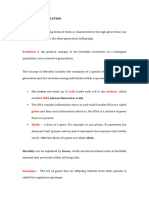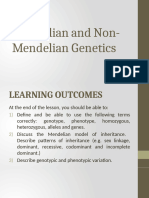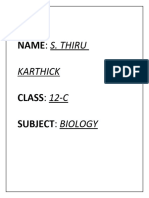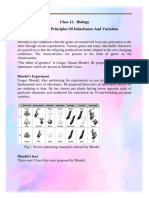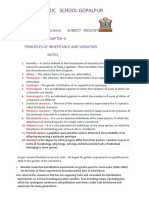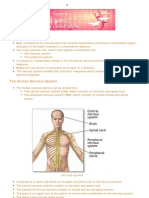0 ratings0% found this document useful (0 votes)
24 viewsCL 12 Bio Chapter-5 Principle of Inheritance and Variation
The document discusses several key concepts in genetics including:
- Mendel's laws of inheritance such as dominance, segregation, and independent assortment which he discovered through his pea plant experiments.
- Other inheritance patterns like incomplete dominance, codominance, polygenic traits, and pleiotropy.
- The chromosomal theory of inheritance which linked genes to chromosomes.
- The role of linkage and recombination of genes during meiosis.
- Examples of genetic disorders and how they are analyzed through pedigree studies.
Uploaded by
jackieaj093Copyright
© © All Rights Reserved
Available Formats
Download as PDF, TXT or read online on Scribd
0 ratings0% found this document useful (0 votes)
24 viewsCL 12 Bio Chapter-5 Principle of Inheritance and Variation
The document discusses several key concepts in genetics including:
- Mendel's laws of inheritance such as dominance, segregation, and independent assortment which he discovered through his pea plant experiments.
- Other inheritance patterns like incomplete dominance, codominance, polygenic traits, and pleiotropy.
- The chromosomal theory of inheritance which linked genes to chromosomes.
- The role of linkage and recombination of genes during meiosis.
- Examples of genetic disorders and how they are analyzed through pedigree studies.
Uploaded by
jackieaj093Copyright
© © All Rights Reserved
Available Formats
Download as PDF, TXT or read online on Scribd
You are on page 1/ 53
Content
• Mendel’s principles of inheritance
-Law of Dominance
-Law of segregation
-Law of independent assortment
• Codominance; incomplete dominance; multiple allelism;
Polygenic inheritance and Pleiotropy
• Chromosomal theory of inheritance
-Linkage and recombination
• Sex Determination- human, insects and birds
• Genetic disorders:
- Pedigree analysis
- Mendelian disorders: Colour blindness; haemophilia; sickle cell
anaemia; phenylketonuria and thalassemia
- Chromosomal disorders: down’s syndrome; klinefelter syndrome and
turner’s syndrome.
Genetics: it is a branch of
biology that deals with the
inheritance of traits and
variation.
Inheritance is the process
by which genetic
information is passed from
parents to progeny. The
information is present in
the genetic code carried by
DNA. Phenomenon of
passing of traits from
parents to offspring is term
as Heredity.
Trait is a distinguish character
or quality of a person.
Variation:It refers to the
differences in the genetic
makeup of individuals in a
population. Eg: eye colour,
blood type, flower colour,
shape of leaves, height of
plants etc.
Genetic makeup of an
organism refers to the sum
total of genes inherited
from the parents.
Mendel’s Law of Inheritance/Mendel’s Inheritance
principles:
Laws of inheritance were Proposed by Gregor Johann
Mendel (1856-1863).
Mendel and his experiment:
Why did Mendel choose garden pea as his experimental
material?
i. Availability of large number of true breed pea with large
varieties of contrasting characters.
ii. Though self pollinating in nature, controlled cross
pollination can be carried out to obtain hybrid plants.
iii. It is an annual plant
iv. Easy to cultivate
Steps followed by Mendel for
his experiment:
I. Selection of parents by
continuous self pollination
of plants with desired traits
(true breed)
II. Hybridization for F1
generation by using homozygous
parents.
III. Self breeding for F2 and F3
generation.
Mendel used 7 pairs of
contrasting characters in his
experiment on inheritance of
traits.
List of 7 contrasting traits used by Mendel
Inheritance of one gene:
Law of Dominance: This law states
that in a pair of dissimilar factors,
one factor dominates over the
other factor and expressed itself in
F1 generation. The factor that
expresses itself is called Dominant
while the unexpressed factor is
called recessive.
Eg: monohybrid cross (Height)
between purebred tall and dwarf
pea plants. Mendel found that all
F1 offsprings were phenotypic ally
tall. He self hybridised F1 and
obtained F2 generation which was
a mixture of tall and dwarf plants.
Law of Segregation
This law states that
factors/alleles in a pair
segregate from each
other at the time of
gamete formation i.e
each gamete will
receive only one of the
2 factors.
Eg: A monohybrid cross
between purebred tall
and dwarf plants.
• Phenotype of F2: ¾ Tall: ½ Dwarf (3:1)
• Genotype of F2: 1/4 Homozygous Tall: ½ heterozygous Tall: ¼
Homozygous Dwarf
• Ratio condensed into Binomial expression (ax+by)2
(1/2Tx1/2t)2= 1/4TT+1/2Tt+1/4tt
Test cross: It is a cross carried out between the F1/F2 progeny of
unknown trait with a recessive homozygous parent plant.
• It was a method used by Mendel to determine the genotype of a
progeny.
Reciprocal cross: It is a
cross where phenotype
of each parent is
reversed as compared
with the original cross.
• It is done to fine the role
of the parental sex on
inheritance.
• Eg: if in the original
cross, male parent is tall
and female parent is
dwarf plant, then in
Reciprocal cross, the tall Fig: original cross and reciprocal between a
plant is used as female purebreed pea plants with yellow and green
parent and a dwarf seed.
plant as male parent.
Punnett Square: It was
developed by Reginald C.
Punnett.
• It is a graphical
representation to calculate
the probability of all
possible genotypes of
offspring in a cross.
• Possible gametes written on
two sides on the top and left
columns
• Mathematically shown using
binomial expression- (a+b)2
• Phenotypic ratio: It is
the ratio that represent
the relative no. of times
an offspring of particular
trait is appearing in a
generation. It can be
determine by doing test
cross.
• Genotypic ratio is ratio
of the number of time
the genotype would
appear in a offspring
after a test cross.
Fig: Self-fertilisation of F1 generation
Points to remember:
• Something was being transfer from the parent to
offsprings. Mendel called them Factors
• A character is controlled by pair of factors. Johanssen
coined the term ‘Gene’ for Mendel’s Factor. Pair of genes
controlling different forms of a character are called alleles.
Eg: T and t
Genotype refers to the total set of genes present in the DNA
of an organism.
Phenotype refers to the physical appearance of an organism
which controlled by genotype. Eg: skin colour.
• When alleles are identical, they are said to be
homozygous. Eg: TT, tt. Whereas dissimilar pair of alleles
are said to be heterozygous. Eg: Tt
Incomplete Dominance
In a hybridised cross, when the
dominant allele does not
completely masked the effect of
the recessive allele, such cross
results in an offsprings of F1
generation which does not
resemble either of the parents
but appear between the two.
Such phenomenon is called
incomplete dominance.
Eg: Monohybrid cross between
purebred red flowered and
white flowered Snapdragon.
Co-dominance:
It is a condition where both
the alleles of a gene pair in a
heterozygote fully express
themselves independently
when present together in a
hybrid. Eg: ABO blood group,
Roan cow etc.
In a cross between a
purebred white coat cow
and purebred brown coat
cow, all the F1 hybrids had
roan coat.
Co-dominance in blood group types
Multiple allelism: when a
trait is control by more than
two alleles, the
phenomenon is term as
multiple allelism and the
form genes that control the
different form of traits are
said to be multipl
e alleles. Eg: blood group
ABO.
Q. What are the possible
blood types of the
Figure: cross between a male with heterozygous
offspring of a cross for blood group A and female heterozygous for
between individuals that blood group B.
are type AB and type O?
Law of independent assortment
• This law states that in a dihybrid
cross involving two pair of
characters, separation of one pair
of character is independent of
the other pair.
• Eg: dihybrid cross between Yellow
Round seed and Green Wrinkled
seed
• Segregation of 50% R and 50% r
is independent from 50% Y and
50% y. Hence, 50% of gamete
with r will have Y while the other
50% y and vice versa.
•
Polygenic Inheritance
• A phenomenon where a single
trait/phenotypic character is
control by many genes
• Such genes are called
polygenes and are located in
different loci
• Character is known as polygenic
character
• Eg: skin colour; control by
genes ‘AABBCC’, ‘AaBbCc’,
‘aabbcc’ etc.
• Locus (pl: loci)- a specific
position of a genes in a
chromosome/s
•
Pleiotropy (Pleotropism)
• It is a condition where one
gene produces more than
one phenotypic effects which
are totally unrelated.
• Pleiotropy is seen mostly in
genes that has effect on
metabolic pathways which
contribute towards different
phenotypes.
• Eg: phenylketonuria is an inborn error of metabolism Caused
by mutation on autosomal recessive gene present on
chromosome no. 12
• It is due to failure of production of phenylalanine
hydroxylase which is essential for the conversion of amino
acid phenylalanine to tyrosine
• Accumulation of phenylpyruvic acid in the brain leading to
mental retardation, Delay growth, reduction in hair and
skin pigmentation.
Why Mendel work was not recognized immediately?
1. Communication was not easy
2. Genes as a stable and discrete units
that controlled expressions of traits
and that pair of alleles didn't blend
with each other for continuous
variation were not accepted
3. Use of mathematics to explain
biological phenomenon was new
and not acceptable
4. He could not provide physical proof
for existence of factors
In 1900, de Vries, Correns and Von
Tschermak rediscovered Mendel's result
of inheritance.Later in 1902, presence of
chromosomes inside nucleus was
discovered and cell division was studied.
Chromosomal theory of inheritance
In 1902, Walter Sutton and Theodore
Boveri explain the parallelism between
the chromosomes and Mendel’s factor.
The combined knowledge of
chromosomal segregation and
mendelian principles is popularly
known as chromosomal theory of
inheritance. It states:
1. Both genes and chromosomes occurs in
pairs
2. Pair of genes is located on homologous
sites on homologous chromosomes.
3. Pairing and segregation of homologous
chromosomes lead to the segregation
of the pair of genes.
Chromosomal theory was verified by Thomas Hunt Morgan and his
colleagues. They also discovered that the basis of variation lies in
sexual reproduction. The worked was carried out on Drosophila
melanogaster.
Linkage and Recombination
It is the phenomenon in
which linked genes tend to
go together in the same
gamete as a result of which
the parental combinations
are obtained in greater
frequency than expected in
the progeny.
Eg: Dihybrid cross between
white eyed, yellow bodied
(F) Drosophila with wild
type (M).
Recombination: the phenomenon of separation of linked genes to
form new combination of genes is known as recombination.
• Genes so formed are called recombinants. It results due to
crossing over during meiosis and lead to variations. Crossing
over occurs when distance between two genes present in a
chromosome are more.
Gene mapping: a method of identifying locus of a gene and distance
between genes. It is developed by Thomas Morgan and his students
Sex determination
It refers to the biological system that
determines the sexual characteristics in
an organism. Most of the sexually
reproducing organisms have two sexes
while few of them may be bisexual. The
concept that sex determination lies in
chromosomes was developed by
Hermann Henking in 1891 by carrying out
cytological studies on insects. He
discovered specific nuclear structure
during spermatogenesis in insects.
•He found that 50% of sperms
received the structure while 50% did
not. The structure was named as X
body but he could not explain the
significance. Later it was that this
structure was a chromosome and
named as X chromosome.
Types of sex determination:
1. XX-XO type: this type of sex
determination is seen in most of the
insects including grasshopper. The
female carries pair of identical sex
chromosomes i.e., XX chromosomes
(AA+XX).
All the eggs produced have X
chromosomes. The male carries only
single sex chromosome i.e., XO
chromosome (AA+XX). During
spermatogenesis male produces 2
types of sperms i.e., one type of
sperm with X chromosome (A+ X)
and the other type without X
chromosome (A+0).
2. XX-XY type: seen in Drosophila and
human. The female have identical sex
chromosomes i.e., XX chromosomes
(AA+XX) and male have dissimilar sex
chromosomes i.e., XY chromosomes
(AA+XY).
Female produces one types eggs with X
chromosome i.e., A+X while male
produces 2 types of gametes: one type
with X chromosome and the other type
with Y chromosomes i.e., A+X or A+Y.
In above types of sex determination,
the male produces 2 types of gametes.
This condition is termed as male
heterogamy.
3. ZW- ZZ type: seen in birds where
the females have a pair of dissimilar
sex chromosomes, this is term as
female heterogamy. All the sperms
produced during gametogenesis will
have only one type of sex
Fig: ZW-ZZ type sex determination
chromosomes i.e., Z chromosome.
while the female will produced 2
types of eggs, one with Z
chromosome and the other with
W chromosomes.
4. Z0-ZZ type: seen in butterflies
and moth. The males have paired
of sex chromosomes and produces
one type of male gametes i.e., A+Z
while the female have only single
sex chromosome and produces 2
types of eggs, one with Z
chromosomes (A+Z) and the other
Fig: ZO-ZZ type sex determination
without Z chromosomes (A+O).
5. Sex determination in honey
bees: sex determination in bees
depends on the sets of
chromosomes they received. An
offspring formed from the union
of sperm (16) and egg (16)
developed into female worker
bee or queen bee while the
unfertilized egg (16) having only
haploid set of chromosomes
developed into drone (male bee). The drone produces sperms
This condition is called by mitosis. Thus drones
haplo-diploid sex determination. does not have father but
they have grand father.
Genetic disorders
Genetic disorder is an inherited
medical condition caused by
change in whole or part of DNA.
Pedigree Analysis: It is the study
of the family history about
inheritance of a particular trait
in several generations of
human. Inheritance of a trait is
represented by a family tree
over several generations. In
human genetics pedigree
analysis is used to trace
inheritance of a specific trait,
abnormality or disease. Each feature in human is controlled
by one or more genes. These genes are located on DNA
present in chromosomes. Therefore DNA is the carrier of
genetic information which is transmitted from generation to
generation without alteration. However alteration may occur
in genetic material which is referred to as mutation. It is the
sudden, permanent heritable change in the sequence of DNA.
It can be :
1. point mutation- change in single base pair (bp)
2. Chromosomal mutation- mutation that take place on a
long segment of DNA
Mutation can be useful, non-lethal or lethal. Non-lethal
mutation causes genetic disorders.
1.
2.
Figure: 1. Gene mutation 2. chromosomal mutation
Types of genetic disorders:
1. Mendelian disorders: It is a
type of genetic disorder
determined by alteration
in single gene which is
transmitted from one
generation to the next in
mendelian pattern. It can
be traced through
pedigree analysis. It can be
controlled by mutated
recessive or dominant
gene which can be present
in autosomes or sex
chromosomes.
1. Colour Blindness
It is an X linked recessive disorder caused by mutation of
a recessive gene present on X chromosome. It occurs in 8% of
males and only 0.4% females and is due the fact that males
have only single X chromosomes and females have XX
chromosomes. It is characterised by defects in red or green
cones of eye and the person is not able to determined
between red and green colour. Female with a single gene for
the disorder is not affected but she is a carrier and has 50%
chances of passing the gene to the son who will be colour. A
single gene though recessive, in male is enough to develop
colour blindness.
The disorder is transmitted from carrier mother to son but
not by father to son. The daughter rarely color blind and has
the chance of developing the disorder only if the mother is
carrier and father is color blind.
Cross between a Carrier female for colorblindness
gene and a normal male
2. Haemophilia
It is an X- linked recessive disorder and is transmitted through
unaffected carrier female (heterozygous) to her son. The disorder
develops due mutation in the gene that synthesizes the protein
involved in blood clotting. A simple cut in an individual with the
disorder will lead to non-stop bleeding leading to dead.
In male presence of only one gene on X chromosome, able to can
develop the disorder.
• The infected person lacks clotting factors VIII and IX. A simple
cut causes non stop bleeding.
Sickle Cell Anaemia
• It is caused by mutation of
an autosomal recessive
gene present on
chromosome 11 and the
allele is represented by HbS
• Heterozygous for the genes
are not affected but carrier
of the genes. In this
disorder, the six amino acid
in the β globin chain,
Glutamic acid is replaced by
valine due to substitution of
6th codon GAG to GUG.
• The disorder is characterised by
polymerisation of mutant
haemoglobin at low oxygen
tension changing the biconcave
RBCs into elongated sickle
shape cells. Hence name sickle
cell anaemia.
• RBCs become fragile and prone
to rupture, decreasing their
count in the blood.
Thalassemia
• It is caused by mutation of
autosomal recessive genes on
chromosomes 16 and 11 and
affect the globin chain (α and β
chains).
• Mutation causes deletion of one or
more genes that regulate synthesis
of globin protein.
• It is of 2 types: α and β
thalassemia
• α thalassemia is controlled by • This results in reduced
two linked genes, HBA1 and formation of α and β globin
HBA2 present on chromosome 16 chains therefore lesser
and β thalassemia is controlled globin chains are produced.
by mutant HBB genes present on
chromosome 11.
Chromosomal Disorders
• these are disorders caused Fig 1:
Aneuploidy
by abnormal arrangement
of chromosomes
• It can be due to failure of
segregation of
chromosomes during cell
division- aneuploidy or
increase in the no. Of
whole sets of
chromosomes due to
failure of cytokinesis-
polyploidy (in plants).
Fig: 2. Polyploidy
Down’s Syndrome
• First explained by Langdon
Down in 1866.
• Cause due to the presence
of additional chromosome
in chromosome no. 21
(trisomy)
• Characteristics: short
height, small round head,
fissured tongue and mouth
partially open, broad palms,
mentally retarded.
• Trisomy- 3 chromosomes
instead of normal 2.
Klinefelter's Syndrome
• It is a chromosomal disorder
caused due to additional X
chromosome. The affected
individual is male. He will have
47 (44+XXY) chromosomes
instead of normal 46.
• The person will have reduced
testes, delay or no puberty,
reduced facial and body hairs,
enlargement of breast
(Gynecomastia). They are
infertile.
Turner’s Syndrome
• This chromosomal disorder
arises due to absence of one
sex chromosome i.e ‘XO’
(44+X0) instead of XX ( 44+XX)
and the affected individual is
female.
• Such females are sterile with
rudimentary ovaries and lack
other secondary sexual
characteristics.
Exercise:
1. The factor that expresses itself even in the heterozygous
condition is ____________.
2. Forms of genes are called __________.
3. A cross where inheritance of single trait is studied is called
___________.
4. A cross carried out between an F2 progeny (with unknown
genotype) with the purebred recessive parent is called
___________.
5. Condition where a trait is controlled by more than 2 alleles is
term as ___________.
6. AB blood group is an example of ___________.
7. __________ is the experiment animal used by TH Morgan.
8. _________ is a phenomenon where expression of single gene
results in multiple phenotypic traits which are unrelated.
You might also like
- Alfred Brown, Heidi Smith-Benson - S Microbiological Applications, Laboratory Manual in General Microbiology, Short Version-McGraw-Hill Education (2014) PDF100% (8)Alfred Brown, Heidi Smith-Benson - S Microbiological Applications, Laboratory Manual in General Microbiology, Short Version-McGraw-Hill Education (2014) PDF481 pages
- CBSE Class 10 Science Notes Chapter 9 Heredity and EvolutionNo ratings yetCBSE Class 10 Science Notes Chapter 9 Heredity and Evolution18 pages
- Grade 10 Biology - Notes - CH 9-HeridityNo ratings yetGrade 10 Biology - Notes - CH 9-Heridity6 pages
- Principles of Inheritance and Variation pptNo ratings yetPrinciples of Inheritance and Variation ppt44 pages
- Chapter 9 Heredity and Evolution Note_watermark-1-17 (1)No ratings yetChapter 9 Heredity and Evolution Note_watermark-1-17 (1)17 pages
- Genetics & Heredity@Sseff -256754958643No ratings yetGenetics & Heredity@Sseff -25675495864348 pages
- CBSE Class 10 Science Notes Chapter 9 Heredity and EvolutionNo ratings yetCBSE Class 10 Science Notes Chapter 9 Heredity and Evolution20 pages
- X Science Summary Heredity and EvolutionNo ratings yetX Science Summary Heredity and Evolution4 pages
- L-4 Principles of Inheritance & VariationNo ratings yetL-4 Principles of Inheritance & Variation7 pages
- 5.PRINCIPLES OF INHERITANCE AND VARIATIONNo ratings yet5.PRINCIPLES OF INHERITANCE AND VARIATION31 pages
- Principles of Inheritance and Variation: K C Meena PGT Biology KV Vikaspuri Ii ShiftNo ratings yetPrinciples of Inheritance and Variation: K C Meena PGT Biology KV Vikaspuri Ii Shift44 pages
- Heredity and evolution notes-converted (1)No ratings yetHeredity and evolution notes-converted (1)8 pages
- 10th Cbse Sci Heredity_and_Evolution Notes and Model PaperNo ratings yet10th Cbse Sci Heredity_and_Evolution Notes and Model Paper23 pages
- ilide.info-heredity-and-evolution-prashant-kirad-pr_d2c0638da6c8d2798d4f1ec903795d34No ratings yetilide.info-heredity-and-evolution-prashant-kirad-pr_d2c0638da6c8d2798d4f1ec903795d3413 pages
- PRINCIPLES OF INHERITANCE AND VARIATIONNo ratings yetPRINCIPLES OF INHERITANCE AND VARIATION37 pages
- 1234567890-Biology Chapter Principles of Inheritance and Variation Class 12 Notes (1)No ratings yet1234567890-Biology Chapter Principles of Inheritance and Variation Class 12 Notes (1)10 pages
- Principles of Inheritance and Variation (Class-12) - 1100% (1)Principles of Inheritance and Variation (Class-12) - 19 pages
- Topic: Heredity and Evolution - : Subject:Biology CLASS:10100% (1)Topic: Heredity and Evolution - : Subject:Biology CLASS:1018 pages
- Anatomy and Physiology: Human Genetics: Things You Should Know (Questions and Answers)From EverandAnatomy and Physiology: Human Genetics: Things You Should Know (Questions and Answers)No ratings yet
- IGCSE Biology Organisation of The Organism NotesNo ratings yetIGCSE Biology Organisation of The Organism Notes26 pages
- Energy Flow Through An Ecosystem Presentation100% (4)Energy Flow Through An Ecosystem Presentation29 pages
- (Ebook) Plants and Society by Estelle Levetin, Karen McMahon ISBN 9780073524221, 0073524220 all chapter instant download100% (1)(Ebook) Plants and Society by Estelle Levetin, Karen McMahon ISBN 9780073524221, 0073524220 all chapter instant download77 pages
- Cell Cycle and Mitosis Webquest Cells AliveNo ratings yetCell Cycle and Mitosis Webquest Cells Alive4 pages
- Differences Between Mitosis and MeiosisNo ratings yetDifferences Between Mitosis and Meiosis79 pages
- Dog Evolution - Their Domestication History.No ratings yetDog Evolution - Their Domestication History.7 pages
- Overview of The Nervous System: OutlineNo ratings yetOverview of The Nervous System: Outline15 pages
- Alfred Brown, Heidi Smith-Benson - S Microbiological Applications, Laboratory Manual in General Microbiology, Short Version-McGraw-Hill Education (2014) PDFAlfred Brown, Heidi Smith-Benson - S Microbiological Applications, Laboratory Manual in General Microbiology, Short Version-McGraw-Hill Education (2014) PDF
- CBSE Class 10 Science Notes Chapter 9 Heredity and EvolutionCBSE Class 10 Science Notes Chapter 9 Heredity and Evolution
- Chapter 9 Heredity and Evolution Note_watermark-1-17 (1)Chapter 9 Heredity and Evolution Note_watermark-1-17 (1)
- CBSE Class 10 Science Notes Chapter 9 Heredity and EvolutionCBSE Class 10 Science Notes Chapter 9 Heredity and Evolution
- Principles of Inheritance and Variation: K C Meena PGT Biology KV Vikaspuri Ii ShiftPrinciples of Inheritance and Variation: K C Meena PGT Biology KV Vikaspuri Ii Shift
- 10th Cbse Sci Heredity_and_Evolution Notes and Model Paper10th Cbse Sci Heredity_and_Evolution Notes and Model Paper
- ilide.info-heredity-and-evolution-prashant-kirad-pr_d2c0638da6c8d2798d4f1ec903795d34ilide.info-heredity-and-evolution-prashant-kirad-pr_d2c0638da6c8d2798d4f1ec903795d34
- 1234567890-Biology Chapter Principles of Inheritance and Variation Class 12 Notes (1)1234567890-Biology Chapter Principles of Inheritance and Variation Class 12 Notes (1)
- Principles of Inheritance and Variation (Class-12) - 1Principles of Inheritance and Variation (Class-12) - 1
- Topic: Heredity and Evolution - : Subject:Biology CLASS:10Topic: Heredity and Evolution - : Subject:Biology CLASS:10
- Anatomy and Physiology: Human Genetics: Things You Should Know (Questions and Answers)From EverandAnatomy and Physiology: Human Genetics: Things You Should Know (Questions and Answers)
- (Ebook) Plants and Society by Estelle Levetin, Karen McMahon ISBN 9780073524221, 0073524220 all chapter instant download(Ebook) Plants and Society by Estelle Levetin, Karen McMahon ISBN 9780073524221, 0073524220 all chapter instant download



































